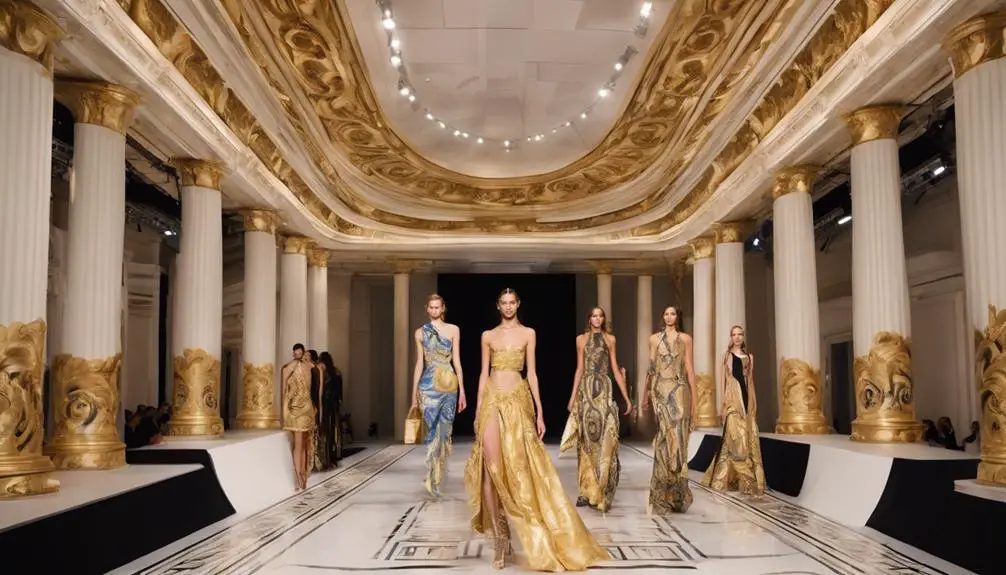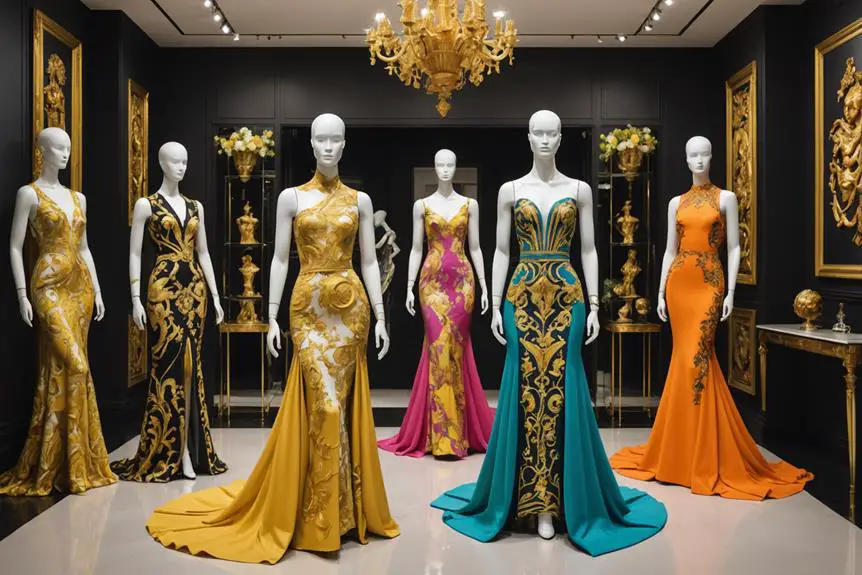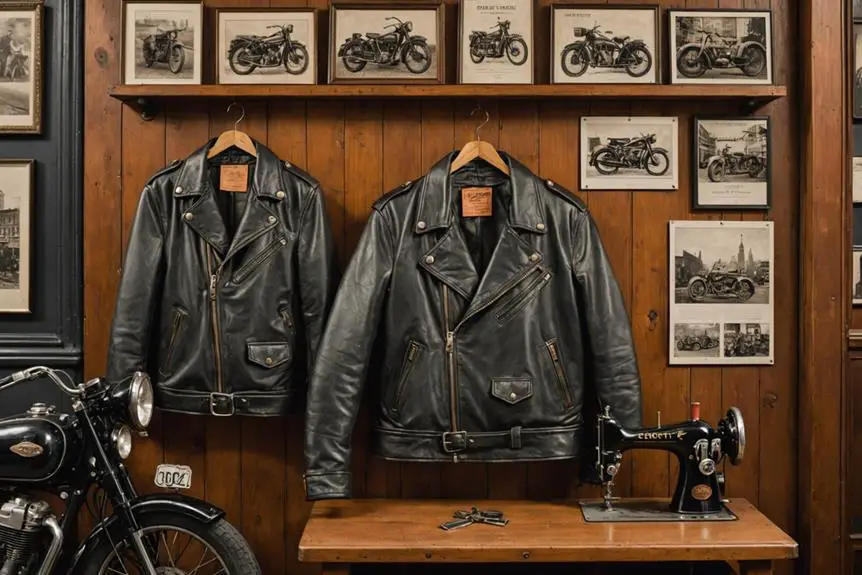The House of Versace has been shaped by iconic designers, starting with its founder, Gianni Versace, who launched the brand in 1978. After his tragic death in 1997, his sister Donatella took over as creative director, breathing new life into the label and appealing to a younger audience. Emmanuel Gintzburger now shares creative direction with her, blending classical elements with contemporary flair. Their innovative designs, like the famous "safety pin" dress, continue to influence fashion trends today. This dynamic leadership guarantees Versace remains a significant cultural force, and there's much more to discover about its impact on the fashion world.
Evolution of Versace Design

The evolution of Versace design has really taken shape since its founding by Gianni Versace in 1978. His first women's collection debuted in Milan, instantly grabbing attention with its bold and colorful aesthetics. Gianni wasn't just a fashion designer; he revolutionized the industry with innovative techniques, like bonding leather and rubber using lasers. These methods set new standards for luxury garments, making Versace synonymous with extravagant style.
Additionally, Gianni's vision focused on empowering women through fashion, merging mythological inspiration with contemporary themes, which can be seen in the brand's use of distinctive motifs and vibrant colors.
Iconic pieces, such as the metal mesh dress, defined the essence of Versace and showcased a daring approach to fashion. However, the brand faced a significant challenge with Gianni's tragic death in 1997. That's when Donatella Versace stepped up, revitalizing the brand with her bold choices and collaborations that captured the world's imagination. One standout moment was Jennifer Lopez's unforgettable green jungle dress at the 2000 Grammys, which not only showcased Donatella's vision but also influenced pop culture in profound ways.
Today, the evolution of Versace design continues to fuse classical inspirations with modern elements. You'll see hints of rock music and royal influences interwoven into collections that push the boundaries of fashion and imagery.
It's a dynamic journey that reflects both the heritage of the brand and the innovative spirit of its designers. With each collection, you can feel the heartbeat of Versace, reminding us that fashion isn't just about clothing; it's about expressing art, culture, and identity.
Key Designers Behind the Brand
Creativity and vision have driven the success of the House of Versace, with key designers shaping its identity over the years. Founded in 1978 by Gianni Versace, the brand quickly gained a reputation for its bold, glamorous, and extravagant collections. Gianni was a pioneer in influential fashion, using vibrant colors and daring cuts that set trends worldwide. His unique style made the House of Versace synonymous with luxury.
After Gianni's tragic death in 1997, his sister, Donatella Versace, took over as the creative director. You could say she revitalized the brand, bringing it into the new millennium with innovative designs that resonated with a younger generation. Donatella faced personal struggles but emerged stronger, implementing fresh marketing strategies and expanding the brand's global presence. Her leadership has been essential in maintaining the House of Versace's relevance.
Today, Donatella shares the creative direction with Emmanuel Gintzburger. Together, they focus on merging classical and contemporary styles, ensuring the brand continues to uphold its luxury status. Their collaborative efforts reflect a commitment to pushing boundaries while respecting the brand's heritage.
Over the years, the House of Versace has also collaborated with various influential designers and artists, further enhancing its cultural relevance. These key figures—Gianni and Donatella Versace—have shaped the identity of the House of Versace, ensuring that it remains a leading name in the world of fashion.
Iconic Collections and Collaborations

Celebrating iconic collections and collaborations, the House of Versace has continually pushed the boundaries of fashion. One defining moment for Versace fashion occurred at the 2000 Grammys when Jennifer Lopez wore the legendary "Jungle Dress." This stunning piece not only captured the world's attention but also led to a surge in the brand's visibility, even sparking the launch of Google Image Search.
Another hallmark of Versace's creativity is the "Medusa" emblem, which symbolizes power and beauty. This iconic logo appears in various collections and collaborations, cementing its status within the brand's identity. The 1992 Spring/Summer collection introduced the daring "safety pin" dress, famously worn by Elizabeth Hurley, which became a symbol of bold and provocative fashion.
Atelier Versace, the haute couture line, showcases exclusive designs crafted with meticulous attention to detail and luxurious materials. This line caters to a high-profile clientele, ensuring that every piece reflects the highest standards of craftsmanship.
Moreover, collaborations with contemporary artists like Andy Warhol have resulted in unique collections that beautifully blend fashion with art. These projects not only reinforce Versace's innovative spirit but also highlight the brand's cultural relevance.
Each iconic collection and collaboration tells a story, making Versace not just a name in fashion, but a lasting legacy that continues to inspire. When you wear Versace, you're part of a narrative that celebrates artistry and boldness in every stitch.
Impact on Fashion Trends
Versace's bold vision has greatly shaped fashion trends over the decades. Founded by Gianni Versace, the House of Versace introduced innovative techniques that revolutionized Italian fashion. Think of metal mesh and laser bonding—these groundbreaking methods became game-changers, pushing the limits of what fashion could be.
The brand's glamorous aesthetic, characterized by vibrant colors and extravagant prints, defined the 1980s and 1990s. With distinct tag evolution marking different eras, it's hard to miss the impact on fashion trends that Versace created.
One of the most iconic moments was the collaboration with Jennifer Lopez at the 2000 Grammys. That green jungle dress didn't just turn heads; it also sparked the launch of Google Image Search! This event changed how fashion is marketed online, proving that a single dress could launch a thousand searches.
Versace's ability to blend music, art, and fashion set a new standard for the industry. The rise of the supermodel phenomenon can be traced back to this fashion house, as designers began collaborating with celebrities to enhance their cultural relevance.
Today, the emphasis on sensuality, sophistication, and unique designs continues to inspire contemporary fashion trends.
As you explore the world of fashion, remember that the impact of the House of Versace remains a powerful force. Their influence not only shapes luxury fashion but also guarantees that the boldness of their vision continues to resonate with new generations.
Versace's Cultural Significance

At the heart of high fashion, the Versace brand stands as a symbol of luxury and cultural significance. You can't believe the impact the Versace name has had on the fashion world. Gianni Versace's unique designs, from bold colors to sensual cuts, haven't only defined an era but also established Milan as a fashion capital. This legacy continues to resonate today, showcasing the brand's cultural relevance.
Consider these key aspects of Versace's influence:
- Pop Culture Collaborations: The brand's partnerships with celebrities, like Jennifer Lopez, created unforgettable fashion moments. Who can forget the iconic green dress she wore to the Grammys?
- Supermodel Phenomenon: Versace played a pivotal role in the rise of supermodels in the 1990s. Their stunning military jackets and glamorous gowns graced runways and magazine covers, solidifying their status as fashion icons.
- Lasting Inspiration: The designs continue to inspire modern fashion. The brand remains a powerhouse, valued at over $5 billion, proving that its creativity and vision have a timeless appeal.
The Versace brand isn't just about clothing; it's about a lifestyle that merges art, music, and fashion.
The cultural significance of Versace transcends mere garments, evolving into a statement of identity and expression. It's clear that Versace will remain influential for years to come, as its designs and cultural contributions keep inspiring new generations.





so much wonderful information on here, : D.